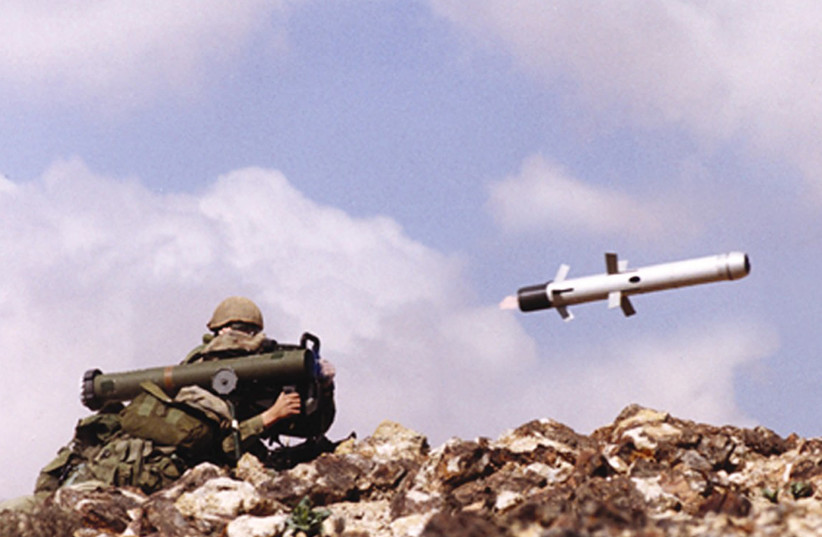Why would a country that prides itself on its indigenous missile technology also claim to be copying its most hated enemy, the “Zionist regime?”
SETH J. FRANTZMAN
APRIL 21, 2020 00:31

Iran’s media bragged on Monday that it reportedly “replicated” an Israeli anti-tank missile. At the same time Iran claims it is now among the best countries in the world in terms of missile innovation. Why would a country that prides itself on its indigenous missile technology also claim to be copying its most hated enemy, the “Zionist regime?”
First, Iran didn’t want to admit these claims itself. In the way things are done in the Middle East this report was ascribed to a Russian news outlet so Iran didn’t have to report it from local sources. But even laundered from the Russians. “A Russian aviation news outlet says Iran may have replicated an Israeli missile that was shot down in Syria,” Press TV claims. Iran’s Tasnim media then goes on to assert that it has now tested this “new Iranian anti-tank missile.”
One can see how Iran helped create this story by noting that Iran’s media, quoting the Russians, then quotes Iranian sources as having been the source of part of this story. “Avia.Pro [The Russian site] quoted experts as saying that Iran may use Israeli missiles against Tel Aviv itself,” Press TV notes So this is Tehran’s real narrative, that it will use Israeli technology against Israel. Iran has done this in the past with the Americans, claiming to jam and bring down a US RQ-170 Sentinel drone in 2011.
Iran then made a drone that looked like a US Sentinel, basically a kind of flying wing. Iran called this the Saeqeh which it has flown since 2014. Iran also built another model based on the Americans, called a Shahed 171. An investigation by Wim Zwijnenbrg at the website Bellingcat noted the similarities. It also noted that this Iranian copy was the same style drone that Iran flew into Israeli airspace in February 2018 that Israel shot down with an Apache helicopter. Iran also copied the US Predator drone to create the Shahed 129 and used a crashed US Scan Eagle drone to design its Qods Yasir UAV.
Iran recently unveiled a plethora of new drones, some of them are part of the Ababil-3 series. This drone was also built by Iran likely after copying a South African model which is itself modelled on an Israeli twin-tail design. Here again Iran simply took what others had done and replicated it.
Iran’s missile arsenal, from the Fajr to Zelzal, Fateh, Shahab series are mostly designed based on foreign missiles such as the Soviet 9K52 Luna-M, Russia’s Scud-C, China’s CSS-8, and North Korean Taep’o-dong, Hwasong-6 and No-dong designs. Iran has improved foreign designs and used its ballistic missiles to affect, targeting ISIS, Kurdish dissidents and US bases in Iraq. In that sense Iran has done more with the missiles in recent operations than the designs it used as a basis.
Herein lies Iran’s mixed record in copying missiles and weaponry of other countries, repackaging it and then claiming that it exceeds what its enemies built. For instance Iran boasts that its drones can fly more than 1,000km and reach altitudes of 45,000 feet. It now claims it has put anti-tank missiles on its drones. This claim appears problematic since Iran’s drone expertise is primarily in using them as suicide drones, basically giving them to Houthis in Yemen or flying them from Iran against Saudi Arabia and other targets. The drones don’t come back to base. This is quite different than what drones generally do when used by the US or others. For instance US Reaper drones carry Hellfire missiles. Iran doesn’t explain how it will communicate with the missiles it has slapped on its drones, all it claims now is that it dropped a missile from a drone on a target.
Iran’s IRGC Aerospace commander Amir Ali Hajizadeh says that Iran now ranks first in the Middle East in missile technology and that it is becoming a global power. Tasnim News repeats the Press TV report that Iran’s anti-tank missile, affixed to an Ababil-3 drone, can be used now in drone flights hours from base. Tasnim argues that the missile can penetrate armored vehicles from the top, where they have weaker armor. Iranian media released images from these tests. It says the Ababil-3 armed drones will be given to the air force. It also alleges Iran has copied an Israeli design. Once again the Iranian claim appears to be a mixed message. If Iran claims to be one of the greatest in rocket technology in the Middle East, why does it need to copy others? Why didn’t it develop its own anti-tank missile for its drones? Why is it basically using drone models of others and missile models of others.
Iran’s media doesn’t explain this apparent contradiction, but it is bragging that it will use these weapons as part of the “axis of resistance” against the US and Israel. These reports come as Iran continues to say it will expel the US from Iraq and the Persian Gulf. Iran often threatens to attack Israel and Iran’s media has recently highlighted Hezbollah threats to Israel.
Content retrieved from: https://www.jpost.com/Middle-East/Iran-News/Why-is-Iran-bragging-about-replicating-an-Israeli-missile-625276.